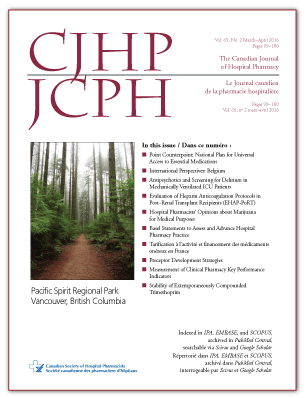Evaluation of Heparin Anticoagulation Protocols in Post–Renal Transplant Recipients (EHAP-PoRT Study)
DOI:
https://doi.org/10.4212/cjhp.v69i2.1538Keywords:
kidney transplantation, heparin, postoperative anticoagulation, hemorrhage, thrombosis, transplantation rénale, héparine, anticoagulation postopératoire, hémorragie, thromboseAbstract
ABSTRACT
Background: Disturbances in hemostasis are common among renal transplant recipients. Because of the risk of thromboembolism and graft loss after transplant, a prophylactic heparin protocol was implemented at St Paul’s Hospital in Vancouver, British Columbia, in 2011. Therapeutic heparin is sometimes prescribed perioperatively for patients with preexisting prothrombotic conditions. There is currently limited literature on the safety and efficacy of heparin use in the early postoperative period.
Objectives: The primary objectives were to document, for patients who underwent renal transplant, the incidence of major bleeding and of thrombosis in those receiving therapeutic heparin, prophylactic heparin, and no heparin anticoagulation in the early postoperative period and to compare these rates for the latter 2 groups. The secondary objectives included a comparison of the risk factors associated with major bleeding and thrombosis.
Methods: Adult patients who received a renal transplant at St Paul’s Hospital between January 2008 and July 2013 were included in this retrospective cohort study. Electronic health records and databases were used to divide patients into the 3 heparin-use cohorts, to identify cases of major bleeding and thrombosis, and to characterize patients and events. The Fisher exact test was used for the primary outcome analysis, and descriptive statistics were used for all other outcomes.
Results: A total of 547 patients were included in the analysis. Major bleeding was observed in 6 (46%) of the 13 patients who received therapeutic heparin; no cases of thrombosis occurred in these patients. Major bleeding occurred in 8 (3.0%) of the 266 patients who received prophylactic heparin and 9 (3.4%) of the 268 who received no heparin (p > 0.99). Thrombosis occurred in 1 (0.4%) and 3 (1.1%) of these patients, respectively (p = 0.62). Major bleeding occurred more frequently among patients with a low-target heparin protocol, but 61% of values for partial thromboplastin time were above target. A larger proportion of deceaseddonor transplant recipients who had major bleeding were taking antiplatelet agents, relative to living-donor transplant recipients.
Conclusion: Therapeutic use of heparin increased the risk of bleeding among renal transplant recipients, but there were no cases of thrombosis. Prophylactic use of heparin did not increase the risk of bleeding and prevented proportionately more cases of thrombosis relative to no anticoagulation; this result supports the continued use of prophylaxis.
RÉSUMÉ
Contexte : Les troubles de l’hémostase sont courants chez les patients ayant subi une transplantation rénale. Comme il existe des risques de thromboembolie et de perte du greffon après une greffe, un protocole d’administration d’héparine prophylactique a été mis en place en 2011 à l’hôpital Saint-Paul de Vancouver, en Colombie-Britannique. On prescript parfois l’héparine thérapeutique en période périopératoire à certains patients affligés d’un état prothrombotique préexistant. Il n’y a actuellement que peu de documentation sur la sécurité et l’efficacité de l’utilisation d’héparine au début de la période postopératoire.
Objectifs : Les objectifs principaux étaient de documenter les incidences de cas d’hémorragie importante et de thrombose chez les patients ayant subi une transplantation rénale et ayant reçu des doses thérapeutiques d’héparine, des doses prophylactiques d’héparine ou aucun anticoagulant au début de la période postopératoire ainsi que de comparer les incidences des cas entre les deux derniers groupes. Les objectifs secondaires incluaient la comparaison des facteurs de risque associés à une hémorragie importante et à une thrombose.
Méthodes : Les patients adultes retenus dans la présente étude de cohort rétrospective avaient subi une greffe rénale à l’hôpital Saint-Paul entre janvier 2008 et juillet 2013. Des dossiers de santé informatisés et des bases de données ont servi à séparer les patients en trois cohortes selon l’utilisation ou non et la dose d’héparine afin de déceler les cas d’hémorragie importante et de thrombose et afin d’offrir un portrait des patients et des événements. Le test exact de Fisher a été employé pour l’analyse des principaux paramètres alors que l’on a utilisé des statistiques descriptives pour tous les autres paramètres.
Résultats : Au total, 547 patients ont été retenus pour l’analyse. Des hémorragies importantes ont été observées chez 6 (46 %) des 13 patients ayant reçu de l’héparine thérapeutique. Aucune thrombose n’a été relevée chez ces patients. Des hémorragies importantes ont été observées chez 8 (3,0 %) des 266 patients ayant reçu de l’héparine prophylactique et chez 9 (3,4 %) des 268 patients n’ayant pas reçu d’héparine (p > 0,99). Des thromboses ont été observées respectivement chez 1 (0,4 %) et 3 (1,1 %) de ces patients (p = 0,62). Un plus grand nombre de patients ont souffert d’hémorragies importantes avec un protocole à valeurs cibles inférieures pour l’administration d’héparine, mais 61 % des valeurs pour le temps de thromboplastine partielle étaient au-dessus de la cible. Parmi les patients qui ont souffert d’hémorragies importantes et dont le donneur était décédé, une plus grande proportion prenaient des antiplaquettaires.
Conclusion : L’administration thérapeutique d’héparine a accru les risques d’hémorragie chez les greffés rénaux, mais il n’y a pas eu de cas de thrombose. L’administration prophylactique d’héparine n’a pas augmenté les risques d’hémorragie et elle a permis d’éviter proportionnellement plus de cas de thrombose que l’absence d’anticoagulant; ce résultat vient appuyer l’utilisation d’héparine prophylactique.
Downloads
Published
Issue
Section
License
After publication of a manuscript in the CJHP, the authors of the manuscript must obtain written permission from the CSHP (publications@cshp.ca) before reproducing any text, figures, tables, or illustrations from the work in future works of their own. If a submitted manuscript is declined for publication in the CJHP, all said rights shall revert to the authors. Please note that any forms (e.g., preprinted orders and patient intake forms) used by a specific hospital or other health care facility and included as illustrative material with a manuscript are exempt from this copyright transfer. The CJHP will require a letter from the hospital or health care facility granting permission to publish the document(s).
Copyright © Canadian Society of Hospital Pharmacists.









